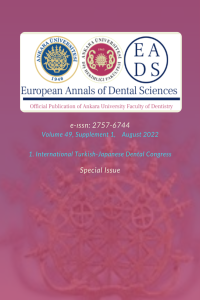Abstract
Aim: Teeth that occur in distant places from the alveolar arch (maxillary sinus, orbit, infratemporal fossa, condylar region, etc.) because of various local or systemic factors are named heterotopic teeth. The heterotopic tooth is a rare phenomenon. Although the etiology is still unknown, it is known that it may be seen due to pathologies caused by cystic lesions, cleft lip-palate, trauma history, and infectious conditions. They are usually asymptomatic, so they are detected by chance in routine clinical and radiological examinations. This study aims to determine the frequency of heterotopic permanent teeth and their anatomical localization with the help of cone-beam computed tomography (CBCT).
Methods: This study was retrospectively performed with CBCT slices. CBCT sections of 2590 individuals (1432 females, 1158 males) between the ages of 10-89 (mean: 44 ± 17 years) were evaluated in the study. Heterotopic teeth were investigated using coronal, axial, sagittal CBCT sections in regions distant from the maxillary-mandibular arch. SPSS V.21 software (IBM Corp., Armonk, NY, USA) was used for data analysis.
Results: Heterotopic teeth were found in 10 of 2590 individuals (0.4%). All of the heterotopic teeth detected are molar teeth; 4 are mandibular third molar teeth, 5 are maxillary third molar teeth and 1 is maxillary second molar tooth. The frequency of heterotopic teeth according to gender did not show a statistically significant difference (4 females, 6 males) p> 0.05. The average age of individuals with heterotopic teeth is 35.3 (17-65 years). 4 of the heterotopic impacted teeth are located in the ramus and 6 in the maxillary sinus.
Conclusions: The prevalence of heterotopic teeth is very rare (0.4%). The teeth with the highest frequency of heterotopia are the third molars. Heterotopic teeth do not have an anatomical location and gender that they prefer predominantly.
Keywords
References
- Kurtuldu E, Sümbüllü MA: Radiologic findings of a heterotopic maxillary third molar. T Klin Diş Hek Bil. 2019;226-30.
- Schuurs A.: Pathology of the hard dental tissues. John Wiley & Sons; 2012.
- Uribe Campos A., Miranda Villasana J. E., Ayala González D. A., Campos Ramírez, L. A. Tercer molar heterotópico en el reborde orbitario: Reporte de un caso y revisión de literatura. Revista ADM 2019;76:287-93.
- Keros, J. & Sušič, M: Heterotopia of the mandibular third molar: a case report. Quintessence int 1997;28.
- Bondemark, L., Tsiopa, J: Prevalence of ectopic eruption, impaction, retention and agenesis of the permanent second molar. Angle Orthod 77, 2007;773-78.
- Elango S., Palaniappan S: Ectopic tooth in the roof of the maxillary sinus. Ear Nose Throat j 70, 1991; 365-66.
- Elsayed SA. Althagafi N, Bahabri R, Alshanqiti MM, Alrehaili AM, Alahmadi AS: Retrospective Radiographic Survey of Unconventional Ectopic Impacted Teeth in Al-Madinah Al-Munawwarah, Saudi Arabia. Open Access Maced J Med Sci 8, 2020; 203-8.
- Iglesias-Martin F, Infante-Cossio P, Torres-Carranza E, Prats-Golczer, VE, Garcia-Perla-Garcia, A: Ectopic third molar in the mandibular condyle: a review of the literature. Med Oral Patol Oral Cir Bucal 17, 2012; 1013.
- Baykul T, Doğru H, Yasan H, Aksoy MÇ. Clinical impact of ectopic teeth in the maxillary sinus. Auris Nasus Larynx 33, 2006; 277-81.
- Vij R, Goel M, Batra P, Vij H, Sonar S: Heterotopic tooth: an exceptional entity. J Clin Diagn res 9, 2015; ZJ06.
Abstract
References
- Kurtuldu E, Sümbüllü MA: Radiologic findings of a heterotopic maxillary third molar. T Klin Diş Hek Bil. 2019;226-30.
- Schuurs A.: Pathology of the hard dental tissues. John Wiley & Sons; 2012.
- Uribe Campos A., Miranda Villasana J. E., Ayala González D. A., Campos Ramírez, L. A. Tercer molar heterotópico en el reborde orbitario: Reporte de un caso y revisión de literatura. Revista ADM 2019;76:287-93.
- Keros, J. & Sušič, M: Heterotopia of the mandibular third molar: a case report. Quintessence int 1997;28.
- Bondemark, L., Tsiopa, J: Prevalence of ectopic eruption, impaction, retention and agenesis of the permanent second molar. Angle Orthod 77, 2007;773-78.
- Elango S., Palaniappan S: Ectopic tooth in the roof of the maxillary sinus. Ear Nose Throat j 70, 1991; 365-66.
- Elsayed SA. Althagafi N, Bahabri R, Alshanqiti MM, Alrehaili AM, Alahmadi AS: Retrospective Radiographic Survey of Unconventional Ectopic Impacted Teeth in Al-Madinah Al-Munawwarah, Saudi Arabia. Open Access Maced J Med Sci 8, 2020; 203-8.
- Iglesias-Martin F, Infante-Cossio P, Torres-Carranza E, Prats-Golczer, VE, Garcia-Perla-Garcia, A: Ectopic third molar in the mandibular condyle: a review of the literature. Med Oral Patol Oral Cir Bucal 17, 2012; 1013.
- Baykul T, Doğru H, Yasan H, Aksoy MÇ. Clinical impact of ectopic teeth in the maxillary sinus. Auris Nasus Larynx 33, 2006; 277-81.
- Vij R, Goel M, Batra P, Vij H, Sonar S: Heterotopic tooth: an exceptional entity. J Clin Diagn res 9, 2015; ZJ06.
Details
| Primary Language | English |
|---|---|
| Subjects | Dentistry |
| Journal Section | Conference Papers |
| Authors | |
| Publication Date | August 31, 2022 |
| Submission Date | September 20, 2021 |
| Published in Issue | Year 2022 Volume: 49 Issue: Suppl 1 |


